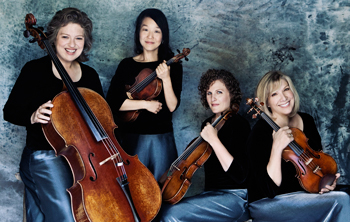by Mike Telin

Annie Fullard is founding first violinist of the Cleveland’s Cavani Quartet (right in photo) and a committed chamber music coach at the Cleveland Institute of Music. Donald Rosenberg served as music critic of the Cleveland Plain Dealer from 1992-2013, and has recently been named editor of Early Music America Magazine. We spoke to them separately by telephone.
Annie Fullard has had hands-on experience with the Bartók Quartets. “I’ve played them a few times now and I love them,” she said. “As a performer and chamber musician, I love that Bartók wanted to synthesize folk music with other compositional elements, some from the seventeenth century and some of his own, as well as his reaction to political and social repression. Combining all of these gives his music an incredible visceral quality both for the performer and for the audience. They are very satisfying and represent something distinctly beautiful and human.”
Donald Rosenberg, who once heard the Takács play all six quartets in Reinberger Chamber Music Hall in a single day, found it “a really intense experience. It takes all of your concentration to filter through all of the details and colors while also seeing the big picture. They are so physiologically relentless that you can’t help but be moved in so many different ways. They’re both exhausting and exhilarating. You will be exhausted by the end but it will be an energizing kind of exhaustion.“
“Bartók was very much influenced by nature,” Fullard said. “The quartets are a synthesis of that, the music of the seventeenth century and the folk music. Each quartet of course represents a different point in his life and in his compositional development so each quartet has a distinct personality. It’s like reading somebody’s diary. It gives you an idea of what was going on and yet there was nothing like them ever before.”
Rosenberg expanded on the idea of the quartets as autobiography. “They’re very emotional pieces, and a lot of the movements are very bleak. I won’t say they reflect Bartók’s emotions at all times, but they may reflect some of his moods during those periods. We are talking about thirty years of string quartet composition, so a lot happened in his life and in the world in those thirty years. And he developed as a composer so strikingly.”
What makes them masterpieces? Rosenberg thinks, “partly because they are so distinctive and they sound like no other string quartets certainly to that time. They expand on what the previous masters created, yet they are in a language that is so unique to Bartók in his use of polyphony, harmony, and the way he creates so many interweaving lines that evoke atmospheres and emotions.”
The uniqueness of Bartók’s approach to the string quartet does make them a challenge for performers. Fullard noted that “Bartók’s quartets are a departure from traditional western compositional styles and you have to challenge yourself to understand that the pitch sets and the rhythms, as complex as they are, are a different language and you have to learn to speak that language.
“They are rhythmically complex and yet if you really learn to dance with them you can do it,” she said. “They are fantastic for quartets to learn. They help you improve your sense of rhythmic consistency and develop your ability to play off of one another like jazz musicians. He also uses a lot of effects like glissandos and pizzicatos and textural elements that can also be challenging. But it’s these challenges that make his quartets so amazing and engaging to play.”

“These works take a lot of concentration on the part of everyone involved, but I think the rewards are great,” Rosenberg added. “Bartók was able to create a language unlike anyone else’s and fashion it in a way that created musical statements, paragraphs and full movements that are dramatic in shape from beginning to end. Structurally I think the quartets are remarkable. Each one is so different in architecture and makes use of the four voices in such distinctive ways.”
One of the composer’s special statements that Fullard loves is the so-called Bartók Pizzicato. “Essentially you pick up the string with two fingers, pull it straight up from the fingerboard and let it drop. That gives it a percussive sound. Again this technique comes from a folk source. It has wonderful texture and color and it’s electric when everyone is snapping at the same time. It’s just a wonderful sound.”
Does Annie Fullard have a favorite among the six quartets? “That is such a difficult question, because I can be totally in love with whichever quartet we are working on at the time. I do like the primal quality of the fourth and fifth quartets. They are both very intense to perform — but I do love the ending to the sixth with all of its Gypsy and Hungarian rhythms.”
But why choose? Donald Rosenberg thinks it’s a wonderful thing that you can hear all six played over the course of two days next week. “When do you get to hear these masterpieces played all at once? They are all so different and so absorbing and haunting that they sustain your interest throughout. It’s a very rich experience — especially to hear the Takács, of all quartets, play them.”
Published on ClevelandClassical.com March 15, 2014
Click here for a printable version of this article.



